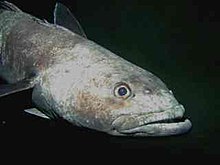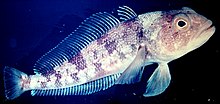Nototheniidae
- In some scientific literature, the term "cod icefish" is used to identify members of this family. This should not be confused with the term "icefish," which refers to the "white-blooded" fishes of the family Channichthyidae. See Icefish (disambiguation).
| Cod icefishes | |
|---|---|

| |
| Head of Antarctic toothfish (Dissostichus mawsoni) in McMurdo Sound | |
| Scientific classification | |
| Domain: | Eukaryota |
| Kingdom: | Animalia |
| Phylum: | Chordata |
| Class: | Actinopterygii |
| Order: | Perciformes |
| Suborder: | Notothenioidei |
| Family: | Nototheniidae Günther, 1861[1] |
| Genera | |
|
see text | |
Nototheniidae, the notothens or cod icefishes, is a
Taxonomy
Nototheniidae was described as a family in 1861 by the German-born British
Genera
The following subfamilies[1] and genera are classified within the family Nototheniidae:[6][2]
- Pleuragrammatinae Andersen & Hureau 1979
- Aethotaxis H. H. DeWitt, 1962
- Dissostichus Smitt, 1898
- Gvozdarus Balushkin, 1989
- PleuragrammaBalushkin, 1982
- Nototheniinae Günther 1861
- Gobionotothen Balushkin, 1976
- LepidonotothenBalushkin, 1976
- Lindbergichthys Balushkin, 1979
- Notothenia Richardson, 1844
- Nototheniops Balushkin, 1976
- Paranotothenia Balushkin, 1976
- Patagonotothen Balushkin, 1976
- Trematominae Balushkin,1982
- Cryothenia Daniels, 1981
- La Monte, 1936
- Trematomus Boulenger, 1902
These subfamilies are not recognised in the 5th Edition of Fishes of the World.[4]
Characteristics
Nototheniidae fishes have fusiform or elongate and oblong bodies. They typically have two
Distribution and habitat
Nototheniidae species are largely found in the Southern Ocean and are particularly abundant off the shores of Antarctica.[7] As the dominant Antarctic fish taxa, they occupy both sea-bottom and water-column ecological niches.[8]
Nototheniidae is a family of teleost fishes found mainly in the Southern Ocean, surrounding the continent of Antarctica. The family comprises about 50 species of fish that are adapted to living in the cold, nutrient-rich waters of the Southern Ocean. The Nototheniidae family includes some of the most ecologically and evolutionarily important fish in the Antarctic ecosystem, making them a crucial subject for scientific study.[citation needed]
Nototheniidae is a family of perciform fish that are primarily found in the Southern Ocean surrounding Antarctica, with some species also occurring in the sub-Antarctic regions of the southern hemisphere. They are known for their unique adaptations to the cold, such as the ability to produce antifreeze proteins to prevent their bodily fluids from freezing. The family includes over 100 species, making it the most diverse group of fish in the Southern Ocean. Nototheniidae inhabits a variety of habitats, from shallow coastal waters to deep ocean trenches. Many species are bottom-dwellers and can be found in rocky areas or on the seafloor, while others are pelagic and swim in the water column. Some species migrate seasonally to different habitats for feeding or spawning purposes. Due to their abundance in the Southern Ocean, Nototheniidae is an important part of the food chain for many marine predators, including seals, whales, and birds.[citation needed]
Biology
Nototheniidae species have no
The concentration of antifreeze glycoproteins can vary with differing environmental conditions, such as colder environments caused by location. Larger amounts of the proteins have been found in species with habitats in higher latitudes, due to the higher expression of the protein and longer degradation time compared to relatives in more temperate regions, portraying flexible temperature regulation.[13]
Some species exhibit
Fisheries
Nototheniidae species are the major fish resource in the Southern Ocean, many notothens are under increasing pressure from commercial fishing, particularly the Patagonian toothfish and the Antarctic toothfish.[15]


References
- ^ PMID 25543675. Retrieved 9 September 2021.
- ^ a b Eschmeyer, William N.; Fricke, Ron & van der Laan, Richard (eds.). "Genera in the family Nototheniidae". Catalog of Fishes. California Academy of Sciences. Retrieved 15 September 2021.
- ^ Christopher Scharpf & Kenneth J. Lazara, eds. (12 April 2021). "Order Perciformes: Suborder Notothenoididei: Families Bovichtidae, Pseaudaphritidae, Elegopinidae, Nototheniidae, Harpagiferidae, Artedidraconidae, Bathydraconidae, Channichthyidae and Percophidae". The ETYFish Project Fish Name Etymology Database. Christopher Scharpf and Kenneth J. Lazara. Retrieved 15 September 2021.
- ^ ISBN 978-1-118-34233-6. Archived from the originalon 2019-04-08. Retrieved 2021-09-15.
- PMID 15288063.
- ^ a b Froese, Rainer, and Daniel Pauly, eds. (2021). "Nototheniidae" in FishBase. June 2021 version.
- ^ ISBN 9780868102115.
- ^ a b Eastman, Joseph (1993). Antarctic Fish Biology: Evolution in a Unique Environment. Academic PressSan Diego, California.
- ^ Vacchi, M; et al. (2017). The Antarctic Silverfish: a Keystone Species in a Changing Ecosystem. Springer International Publishing.
- ^ Farrell, AP & Steffensen, JF (2005). The Physiology of Polar Fishes. Elsevier.
- ^ "Surface Temperature - NOAA's Science On a Sphere". National Oceanic and Atmospheric Administration. 2018.
- PMID 9108060.
- ISSN 1432-2056.
- S2CID 27173180.
- ^ "Back on the menu How smarter fishing practices, improved management and MSC certification have transformed toothfish's fortunes". Marine Stewardship Council. 2018. Retrieved 16 September 2021.
